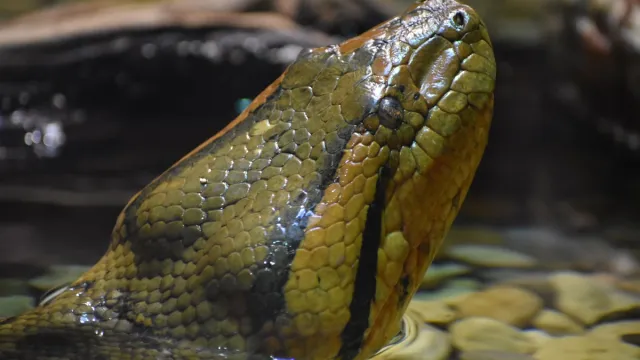Brand New 21-Foot Snake Discovered: “Biggest of All Anacondas”

There are more than 3,000 species of snakes slithering around our planet, and 7 percent of those have the power to fatally injure a human, per National Geographic. It’s no secret that Arizona and Florida are some of the most snake-infested U.S. states, but the rattlesnakes and copperheads found there are no match for the massive anacondas in the forests, swamps, and grasslands of South America. Recently, researchers discovered a new green anaconda variant in the Amazon that stretches nearly 21 feet long and weighs about 800 pounds.
RELATED: Giant Invasive Pythons Are Moving North and “Need an Army” to Be Stopped.
Until recently, the green anaconda was considered one species, but an exciting (or terrifying) discovery has led experts to conclude that the reptile is actually two separate species, according to a new study published in the MDPI Diversity journal.
Researchers revealed that the newly discovered northern green anaconda (Eunectes akayima) is “genetically distinct” from the southern green anaconda (Eunectes murinus)—which scientists believed to be the original species—by 5.5 percent.
In order to differentiate the two kinds of anaconda, researchers collected blood and tissue samples from green anacondas living in Ecuador, Venezuela, and Brazil. They also analyzed genetic data taken from four recognized anaconda snake species in nine different countries.
Their findings determined that two types of green anaconda do in fact exist—and they vary in appearance, too. The variation in scales and other physical traits stipulate an “evolutionary divergence,” as National Geographic reported.
Looks aside, the biggest difference between the northern and southern green anaconda is geographic range. While both species can be found in the Amazon, one resides in the southern basin while the other lives in the north.
“The southern green anaconda (Eunectes murinus) is found across a vast range spanning Brazil, Bolivia, Perú and parts of French Guiana,” study co-author Bryan Fry, a National Geographic explorer and biologist teaching in Australia, told Fox News Digital.
“By contrast, our newly described northern green anaconda (Eunectes akayima) is restricted to Colombia, Ecuador, Guyana, Suriname, Trinidad, Venezuela and parts of French Guiana,” he explained.
RELATED: First Rattlesnake Bite of the Year Prompts Urgent New Warnings.
The scientific breakthrough was captured by National Geographic and will air in the forthcoming Pole to Pole: With Will Smith series.
“The Ecuadorian eastern rain forest has long been rumored to hold the largest of all anacondas, but until our expedition with Will Smith for National Geographic’s Pole to Pole series, this had never been investigated,” Fry shared. “Not only because the area is so incredibly remote, but also because it’s the autonomous lands of the Waorani indigenous people.”
During the exploration, Fry and his colleagues discovered northern green anaconda snakes that were significantly larger in size than southern anacondas. The biggest reptile they laid eyes on measured 20.6 feet long and weighed around 793 pounds.
“It’s clear that the snakes in the Waorani lands are indeed the biggest of all anacondas,” he noted.
If you’re afraid of snakes—or at least the giant ones—you can take some comfort in knowing that these newly discovered anacondas live far outside of the U.S.
But don’t breathe too easy: The northern green anaconda discovery comes on the heels of a slightly more alarming turn of events. Researchers believe that invasive anacondas could actually be breeding and spreading in the U.S.
And that’s to say nothing of invasive Burmese pythons, which are similarly giant and have been multiplying in Florida for the last couple decades. These mighty pythons can weigh up to 200 pounds. In Nov. 2023, a team of six strangers joined forces to wrangle one of these monsters while visiting the Big Cypress National Preserve in Florida.